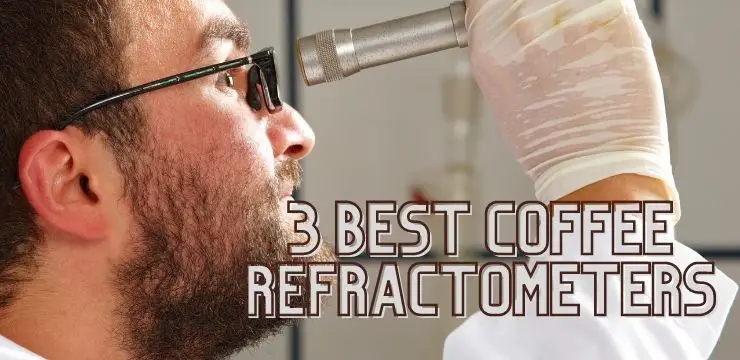This isn’t a question that gets asked a lot by casual coffee lovers but for your aficionados, knowing the best coffee refractometer is an important piece of information.
To cut to the chase, and after some extensive research and testing, the conclusion of our coffee stir experts is that the best refractometer for coffee is the Atago Pocket coffee densitometer.
Please read on for the lowdown and why we chose this as the best refractometer for coffee and also some short reviews of other great coffee refractometers on the market.
Last update on 2024-07-18 / Affiliate links / Images from Amazon Product Advertising API
Atago Pocket Coffee Densitometer
Last update on 2024-07-18 / Affiliate links / Images from Amazon Product Advertising API
Specifications and Features
The Atago pocket coffee densitometer specifications include:
1. Accuracy of +/-0.20% and Temperature Accuracy of +/- 1 degrees c.
2. A range from 0-22% coffee solids is measured
3. A resolution of 0.01% TDS coffee
4. Automatic temperature compensation
5. 20mm prism diameter
6. Minimum coffee sample size of 4 drops in a flat bottom test cuvette or 2ml coffee
7. Length: 55mm
8. Width: 31mm
9. Weight: 100 grams (0.22lbs)
10. Has an automatic shutoff after 5 minutes of inactivity
In Use
We found the Atago pocket coffee densitometer to be the easiest instrument to use with extracted coffee.
The coffee samples can be measured directly into the cleaned and primed prism and then you simply press the button and get your TDS coffee reading.
The coffee readings were consistent and easy to record after multiple coffee samples. We also liked this refractometer because it didn’t require complicated coffee concentration math which means we could actually focus on the coffee instead of trying to figure out our coffee measurements.
Conclusion
In conclusion, we liked the ease of use and accuracy of the Atago and the only small downside is its price.
It is the most expensive instrument on this list but it is well worth the cost if you are serious about coffee.
Amtast Digital Coffee Densitometer
- Function: Coffee concentration with range of 0-25%; Brix measurement with range of 0-30%; temperature displayed; calibration function
- Provide with suction tube and spare protective cover. The function keys are clear and easy to operate. Digital screen with large number, battery power can be displayed.
- Temperature unit converting: Press key “SCALE” more than 2 seconds, meter will display Celsius or Fahrenheit.
- Calibration: No need calibration every time. Drip 3~5 drops distilled water in sample plate, make sure the water and meter temperature is same and standard temperature is 20ºC, then cover it. Press key “CAL” more than 2 seconds until “CAL” flashing, press “CAL” key again, meter will display “END” and show 0.0%.
- Power off: Meter will power off within one minute if no any operation.
Last update on 2024-07-18 / Affiliate links / Images from Amazon Product Advertising API
Specifications and Features
1. Accuracy of +/-0.20% coffee
2. A coffee range from 0-25% TDS coffee solids is measured
3. Resolution of 0.01% TDS coffee
4. Automatic Temperature Compensation (ATC)
5. 20mm coffee prism diameter
6. Minimum coffee sample size of 2ml coffee
7. Length: 170mm
8. Width: 105mm
9. Weight: 350 grams (7.04 oz)
10. Has an automatic shutoff after 5 minutes of inactivity.
In Use
The Amtast has both BRIX and TDS scales to measure both sugar and dissolved solids content in your brew.
We did find that coffee reading taken on coffee samples were inconsistent and required some coffee concentration and math to get an accurate TDS coffee reading.
Conclusion
The main downside is the inconsistencies of the coffee measurements and coffee concentration math that is required with this coffee refractometer. It requires some careful calibration to get accurate results consistently.
The price of this refractometer is reasonable when compared to other instruments on the market, which if you are willing and able to calibrate this refractometer correctly then it is a decent purchase.
FVRYCA Digital Coffee Refractometer
- Measurement Range:0-50%Brix;0-25%TDS;1.3330-1.4200nD.
- Easy to focus and calibrate, accurate testing results guaranteed.
- Light weight, easy to carry.
- ATC Compensation Range(i.e.Built-in Automatic Temperature Compensation System).
- Added a cover for protection the prism glass.
Last update on 2024-07-18 / Affiliate links / Images from Amazon Product Advertising API
Specifications and Features
1. Accuracy of +/-0.20% coffee
2. Resolution of 0.01 coffee
3. Automatic Temperature Compensation (ATC) coffee
4. Range coffee TDS solids is 0-25% coffee
5. Coffee Prism 20mm diameter
6. Minimum coffee sample size of 2ml coffee
In Use
The FVRYCA digital coffee refractometer can be used to measure BRIX and TDS and is reasonably consistent in its results. However, like most coffee refractometers the FVRYCA is not without problems when it comes to coffee calibration.
Many coffee experts suggest using coffee distilled water rather than coffee brewed water coffee to calibrate the FVRYCA first and we found this did indeed give better results.
Conclusion
In conclusion, the FVRYCA is a coffee refractometer with good digital readings coffee but coffee calibration remains an issue. As such, it fails to be a simple plug-and-play type refractometer.
Its price is reasonable for what you get though and we found coffee TDS levels could be accurately read after some careful calibration.
What Is a Refractometer Used For In Coffee?
Before we get on to how the coffee refractometer works, let’s take a look at why coffee lovers should care.
The reason coffee lovers are interested in a more scientific approach to measuring their coffee is that they are trying to find the ultimate cup of coffee. To do that, it makes sense to measure what you can about coffee extraction yields.
The coffee extraction yield refers to the number of dissolved solids in the coffee you should expect from your espresso brew in comparison to the water. This has a major impact on how the coffee tastes.
There are a few things you need to know to determine the extraction yield. This formula is how extraction yield is calculated.
Extraction Yield % = Brewed coffee (g) TDS (%) / Dose (g)
TDS refers to total dissolved solids and dose refers to the coffee sample weight in your brewed coffee.
Coffee refractometers are an instrument that measures the density of a liquid. It turns out that ground coffee beans have lots of solids in them, the main ones being sugars, proteins, and salts.
By measuring these intensive properties during the coffee brewing process with a refractometer you’ll be able to determine your coffee’s taste profile with greater accuracy.
You’ll be able to get more consistent results and coffee taste each time you make your beloved cup of brewed coffee.
So now you know why we like to use a coffee refractometer, how exactly does a digital refractometer work with regards to making espresso coffee just like the coffee professionals do.
The Ideal TDS For Coffee
Of course, we all enjoy different coffee tastes and that includes types of coffee bean. Our quest as amateur baristas is to emulate the specialty coffee we enjoy at our favorite coffee shops.
The quest is to know just how much coffee we should use compared to water. For this, we need to know the total dissolved solids or TDS.
The ideal TDS is somewhere between 90 and 150 PPM. PPM or Parts Per Million refer to how much coffee there is per million particles. So, 150 PPM is 150 coffee solid particles per million particles of water.
This is the coffee refractometer range to aim for if you want your coffee to taste great. This range of total dissolved solids is the best because the diluted coffee grounds are filled with optimal coffee oils and coffee solubles.
This is also the coffee refractometer reading you’ll get when you are making espresso coffee just like coffee professionals do.
How To Use The Coffee Refractometer?
Using a coffee refractometer is a fairly easy process, especially with a digital coffee refractometer which takes the guesswork out of using an optical coffee refractometer.
The process of using coffee refractometers is laid out in the following steps:
1. Measure coffee sample
2. Place a few drops of your coffee on the prism surface of the coffee refractometer
3. View coffee refractometer reading in your selected unit whether it be BRIX (sugar) or TDS (total dissolved solids) units
4. Convert coffee refractometer reading to TDS
5. Calculate extraction yield ratio and select coffee dose size based on coffee yield percentage, ideal coffee extraction is between 18% and 22%.
This coffee refractometer guide to measuring coffee TDS will take you through each of the five steps in detail to help you get the most out of your coffee refractometer, especially when making coffee in professional coffee shops where espresso is available.
How Coffee Strength Is Measured
Once coffee yield is known, coffee strength can be calculated. The coffee strength is measured by ratio and ppt (parts per thousand).
There are different coffee strength ratios and coffee intensities available on the market today. Most coffee refractometers measure between 0-32 total dissolved solids or BRIX reading in percent, but you will find coffee refractometers available that show coffee strength in BRIX, TDS % and coffee PPM.
To calculate coffee ppt/strength you simply need to divide the coffee reading by 28.4 (ppt).
Let’s say your coffee refractometer reads 15%TDS or 30 BRIX; then the coffee ppt would be 15 divided by 28.4 which equals 0.522 coffee ppt or coffee strength of 52%.
Once coffee strength is known, proper coffee dosing can be done to yield the coffee taste profile desired by coffee professionals and coffee lovers alike.
How do you use a Brix refractometer for coffee?
BRIX is a coffee refractometer scale that is used to measure the amount of sugar in a liquid. Just like you can use a coffee refractometer to measure the coffee ppt/strength, you can also use Brix coffee refractometers which are less expensive than coffee-specific coffee refractometers.
A typical BRIX reading coffee refractometer ranges from 0% to 32%; coffee dosed at 18-22% coffee yield has a coffee BRIX reading of 20-25%. If the coffee ppt is 52%, then coffee yield is 18.5%.
This means that coffee dosed by weight should be between 18 and 22 percent coffee solids for optimal taste.


